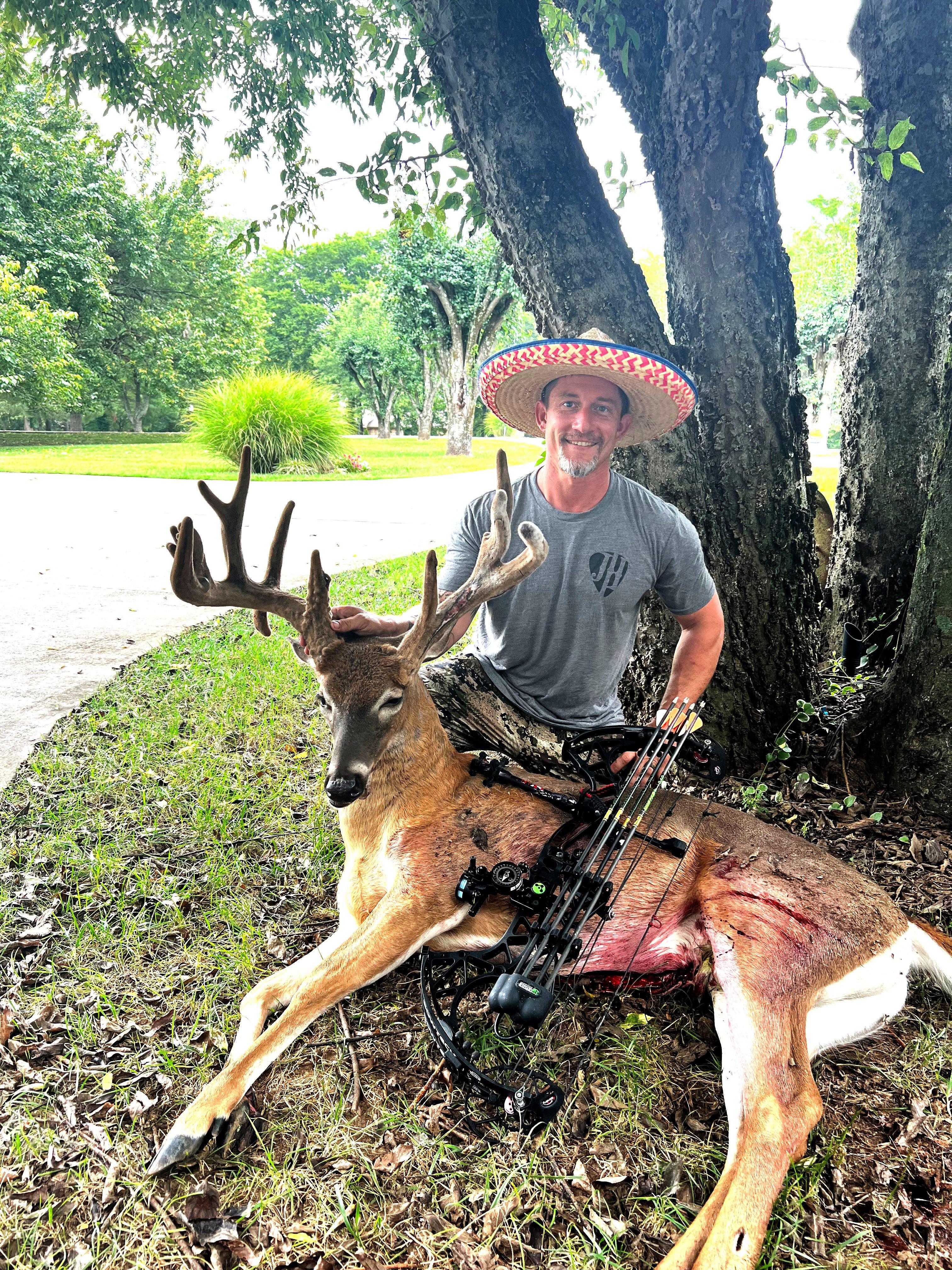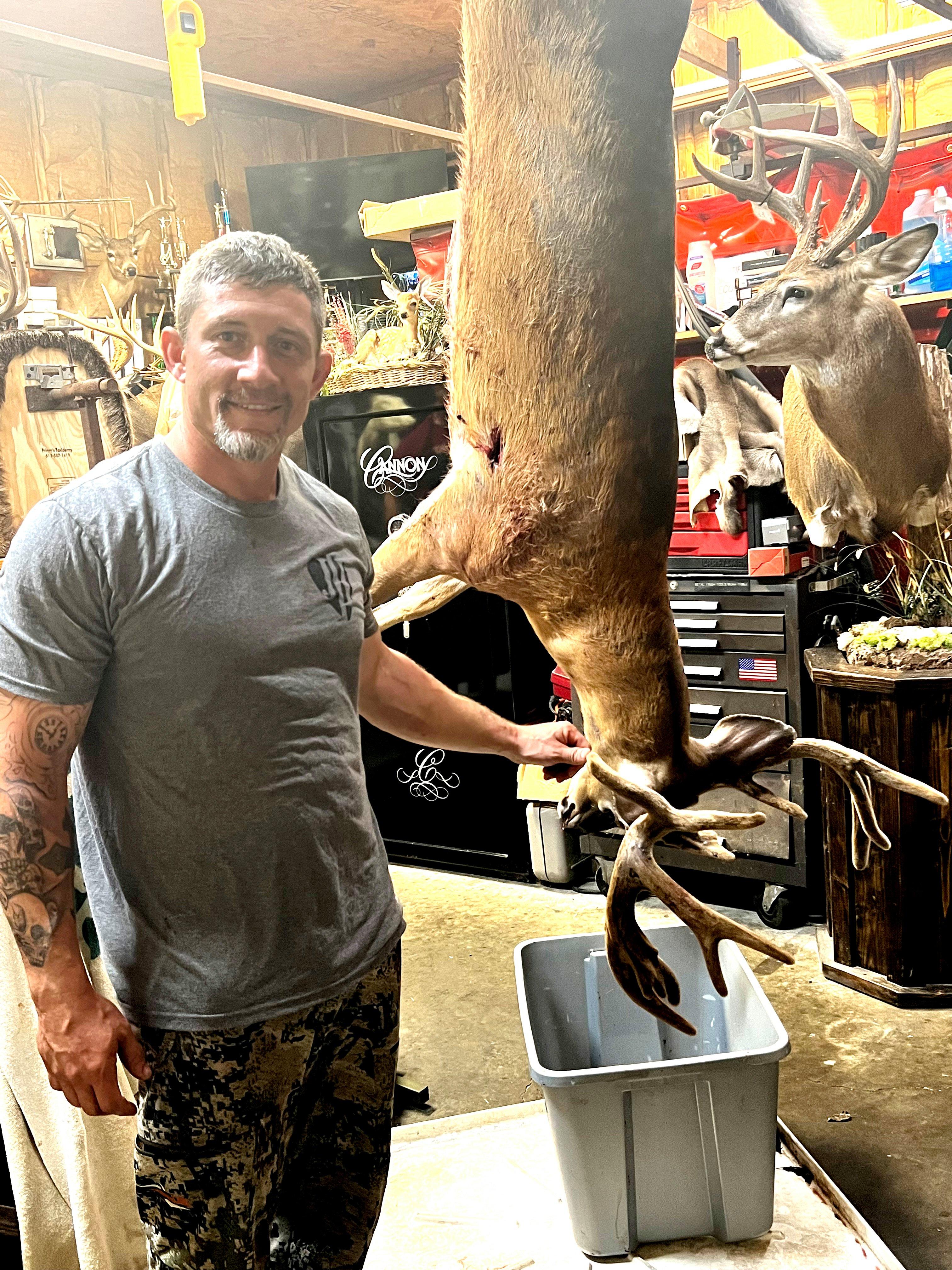The fateful decision to climb down out of the tree before dark pays off for Chase Anderson
| Rack Report Details | |
|---|---|
| Buck: | 168-5/8 |
| Time of Year: | Aug. 26, 2023 |
| Place: | Tennessee |
| Weapon: | Bow: Bowtech Invasion |
It was the second day of Tennessee’s three-day August archery season, and even though there were storms in the forecast, Chase Anderson made the call to hunt the big nontypical buck he’d been watching all summer. He’d skipped the day before, opting to hunt another location because the wind was questionable for the big buck’s normal evening pattern. He knew he’d likely only get one chance and didn’t want to risk an errant breeze blowing his opportunity before he got a shot.

Anderson couldn’t resist the opportunity to don a sombrero for his deer photos in honor of The Three Amigos, a bowhunting contest team he and two buddies had formed.
Anderson had been scouting the buck for more than a month. The deer was in a bachelor group that was bedding in the thick brush of a recently timbered area and would then emerge late in the evening to feed down a cleared power-line right-of-way.
“I’d been glassing these bucks every chance I had,” Anderson said. “They followed the same path down the power line each evening. I picked out a tree that would hopefully be downwind of the buck’s approach that was about 200 yards from where they usually emerged from their bedding area. I knew if the wind would hold, I’d probably get a shot on my first set, so I wanted to wait for everything to be perfect.”
***Don’t Miss: *81 WAYS TO FAIL AT DEER HUNTING
After dropping off his wife at her stand that Saturday afternoon, Anderson headed to tree and got strapped into his saddle. “The wind started out fine but then started to swirl a little as it got closer to dark,” he said. “I was starting to get nervous and was thinking pretty hard about getting down and easing out so I didn’t spook the deer.” As he debated staying or climbing down, the sky opened up with rain. After a 10-minute deluge, things calmed down. The wind was steady in his face, and Anderson decided to stay put for the rest of the evening.

With darkness approaching, Anderson had no choice but to put a spot-and-stalk on the big buck, eventually getting to just 14 yards for the shot.
As darkness approached, he checked the time. It was about 45 minutes until the end of shooting light. He lifted his binoculars and scanned the empty power line. He realized the bucks were running late, perhaps because of the rain.
“I decided at this point that they probably didn’t have time to make it all the way down to my stand location,” he said. “I didn’t want to be climbing down in the dark with them feeding my way and risk bumping them out of the area. I decided to go ahead and ease out early.”
When he was on the ground, Anderson lifted his binoculars to check the power line again before leaving. There stood a buck at 200 yards. It wasn’t his target deer, but it was one of its regular traveling companions. Anderson knew his buck was probably close.
“I thought about it for a minute and then made the call,” he said. “The wind was perfect, and the grass in the power line was between waist- and chest high. There was good cover, and I’d already gotten into bow range of the bucks once before on a scouting trip, so I got down low and started their way.”
***Don’t Miss: *HOW TO DEER HUNT IN THE SOUTH
Anderson slowly cut the distance by 50 to 60 yards. He raised up just enough to glass the power line for the bucks. The lead buck had worked 30 yards closer while he had been cutting the distance. Anderson picked out a pair of saplings 20 yards ahead that he thought would give him cover to draw. He belly-crawled to the small trees and raised up to see over the grass. He expected the lead buck to be about 80 yards out at that point, but the deer had started to move a bit faster and was only 50 yards away. He eased back down and checked his surroundings to make sure he could draw his bow.
Anderson estimated the first buck, an 8-point, scored about 130 inches. He hunkered into the tall grass and tried to control his breathing as the buck passed just 7 yards from his hiding spot. As the buck walked past him, it looked squarely in his direction. Anderson said his heart just about stopped, but after a few seconds, the deer continued down the trail.
The next buck in line was a spike. It too passed just yards from the waiting hunter. The third buck in line was the big nontypical Anderson was after. He raised up just enough to see the big flyer off the right main beam and instantly recognized his target just out of bow range.
Anderson was worried. The low cloud cover and overhanging trees meant that shooting light was rapidly fading. He was also concerned that the lead bucks would soon get downwind of his position and spook, likely taking the big buck with them.
By that time, the buck was in range, but the cover prevented a good shot. “I wanted him to get even with me or just a little past for a quartering-away shot, but I didn’t know if there would be time,” Anderson said. “When the buck looked away, I came to full draw and waited.”
After what seemed like an eternity, the buck’s shoulder passed through an opening just 14 yards from the waiting hunter. He bleated to stop the buck and released his arrow.
The shot sounded good, but the buck spun instantly and bolted away. Anderson watched the deer backtrack the 200 yards to the heavy cover before losing sight of him in the thick underbrush. After a few minutes, Anderson slipped to the spot where the buck had been standing at the shot. The grass was thick and about waist high, making finding any blood in the low light nearly impossible.
As he searched the cover, Anderson felt a drop of rain, and then another. Then the sky opened up again. “It poured down, and I knew any hope of finding blood that night was quickly disappearing,” he said. Confident but not completely certain of the shot, Anderson made the difficult decision to back out for the evening.
“I called my wife and told her what had happened and that I was on my way to pick her up,” he said. “She had more confidence than I did and assured me that my buck was down close. It was a long night.”
Daylight found Anderson back at the location where he’d last seen the buck before it had disappeared into the cover. As suspected, there was no sign of any blood after the night’s heavy rain. Anderson headed the direction he thought the buck was traveling, downhill and toward thick, swampy brush, and began to comb the area with no luck.

Anderson’s buck featured a flyer off the right G2, a branching G4, and a nearly 21-inch inside spread.
After two hours of fruitless searching, Anderson was getting worried. Thinking back to another buck he’d killed in the past that spun at the last minute and backtracked, he headed to the last spot he’d seen the deer and began to search in the opposite direction. There was his buck, just 15 yards from where it had disappeared from sight. The shot had been good, taking out the top of the heart and the bottom of the lungs. He was likely already dead as Anderson had stood searching for blood after the shot. “With the rain, I just didn’t want to risk bumping him the night before,” he said.
Anderson’s buck featured a nontypical velvet frame with a large kicker off the right G2, a branching G4 and a 20-½-inch spread for a green score of 168-⅝. When it came time to take photos, Anderson couldn’t resist the urge to don a sombrero in honor of The Three Amigos, a team he and two buddies had formed for a bowhunting contest they were in.











